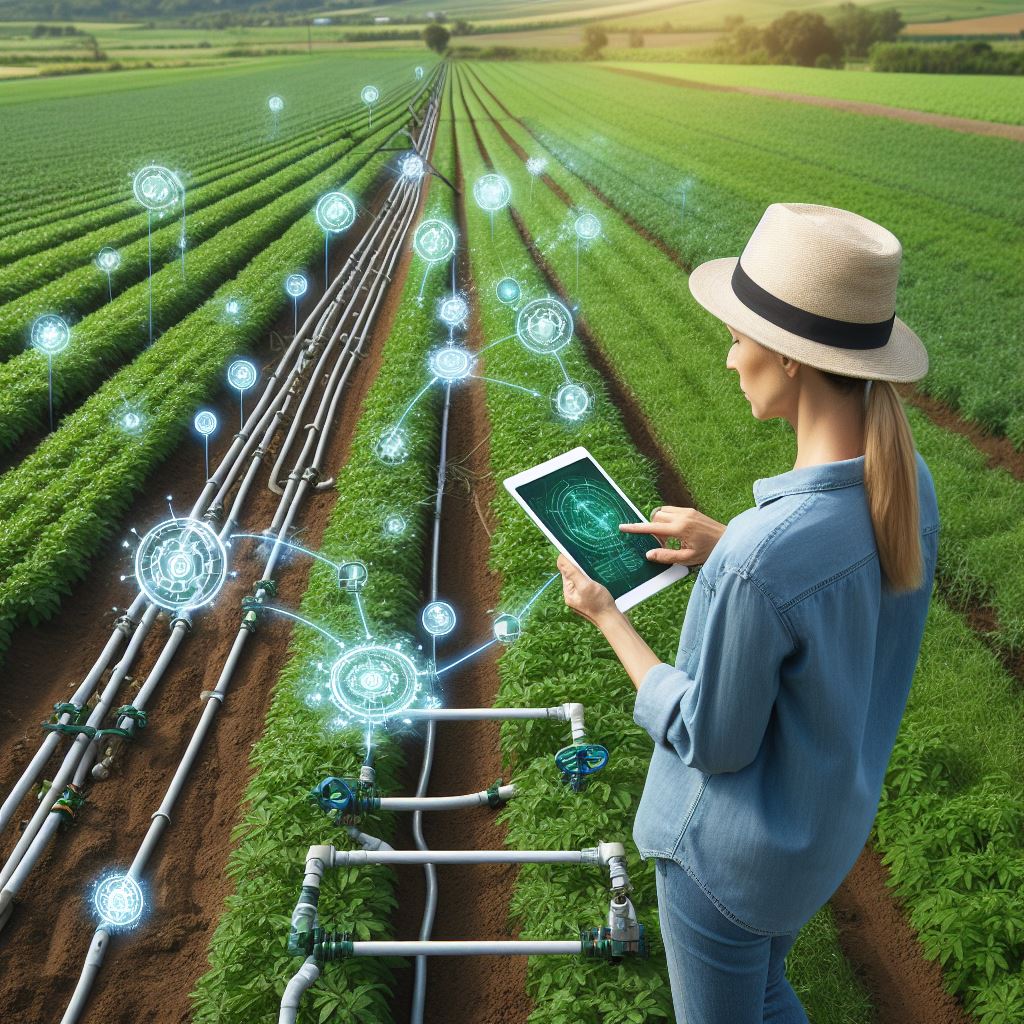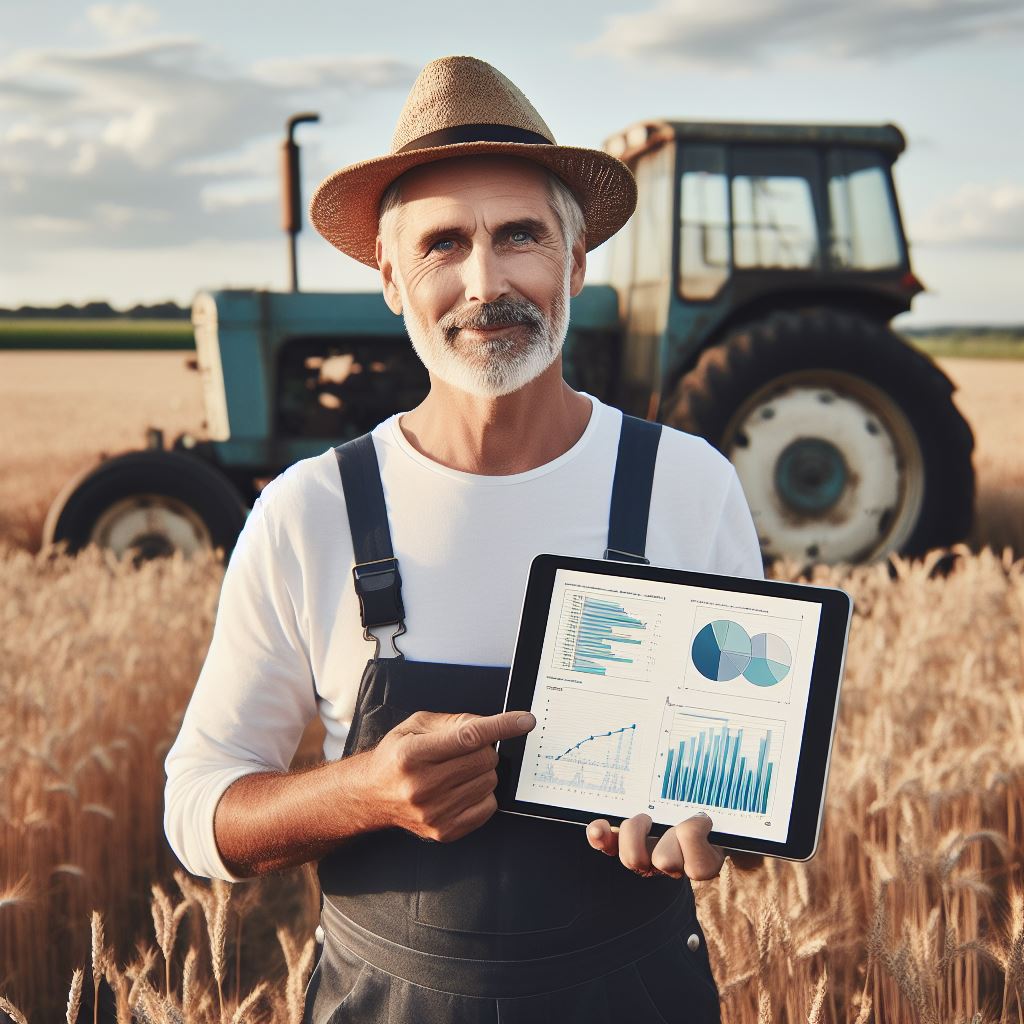Introduction
The development and implementation of automated tractors have reshaped the agricultural landscape.
These advanced machines have transformed the way farmers approach their work.
No longer reliant solely on manual labor, farmers can now take advantage of cutting-edge technology to streamline processes and improve efficiency.
Automated tractors hold immense significance in agriculture.
With their ability to perform tasks without constant human supervision, they enhance productivity significantly.
These tractors can effectively analyze and respond to environmental factors, optimizing crop output.
By leveraging artificial intelligence and sensors, they can assess soil conditions, monitor moisture levels, and precisely apply fertilizers and pesticides.
The implications of automated tractors for the future of farming are vast.
These machines reduce the need for hands-on labor, allowing farmers to focus on strategic planning and decision-making.
The ability to remotely control tractors using GPS and other advanced systems makes farming much more convenient and flexible.
Moreover, automation minimizes human error and promotes sustainability.
By precisely managing input usage, automated tractors reduce waste and environmental impact.
They also mitigate physical strain on farmers, reducing the risk of occupational injuries and increasing overall safety.
In essence, automated tractors represent the future of farming. Their technological advancements enhance productivity, efficiency, and sustainability in agriculture.
As these machines continue to evolve, they will undoubtedly play a pivotal role in feeding an ever-growing global population.
Transform Your Agribusiness
Unlock your farm's potential with expert advice tailored to your needs. Get actionable steps that drive real results.
Get StartedThe future of farming is here, driven by automated tractors.
Evolution of Tractor Technology
Brief history of traditional tractors and their limitations
- Traditional tractors have been the backbone of farming for centuries.
- These tractors operated manually, requiring a skilled driver to control their movements.
- They were equipped with basic mechanical systems and lacked advanced technology.
- Traditional tractors had limited power and were not efficient in handling heavy-duty tasks.
- These tractors were also prone to accidents due to human error and fatigue.
- Farmers faced challenges in optimizing productivity and reducing labor-intensive tasks.
Introduction of semi-automated tractors and their advantages
- Semi-automated tractors revolutionized the farming industry with their advanced features.
- These tractors introduced automated steering systems, reducing the need for constant driver input.
- They were equipped with sensors and GPS technology for accurate navigation and precision farming.
- Semi-automated tractors enabled farmers to increase efficiency and yield through precise field operations.
- These tractors reduced driver fatigue and allowed for optimal utilization of available resources.
- Farmers experienced improved productivity, reduced costs, and enhanced crop quality.
Emerging technology of fully automated tractors
- The future of tractor technology lies in fully automated tractors.
- Fully automated tractors utilize artificial intelligence and advanced sensory systems.
- They are capable of performing complex tasks without any human intervention.
- These tractors can autonomously navigate fields, adjust their speed, and optimize their routes.
- Fully automated tractors utilize real-time data to enhance farming operations and decision-making.
- They can perform tasks with precision and accuracy, resulting in increased efficiency and reduced waste.
- Farmers can monitor and control the operations of these tractors remotely through mobile applications.
- Fully automated tractors significantly reduce labor requirements and enable farmers to focus on other aspects of farming.
- These tractors have the potential to revolutionize agriculture by maximizing productivity and sustainability.
The evolution of tractor technology has come a long way, from traditional manual tractors to semi-automated and fully automated tractors.
While traditional tractors had limitations in terms of power and efficiency, the introduction of semi-automated tractors brought significant advancements in precision farming and productivity.
However, the future lies in fully automated tractors that can perform complex tasks autonomously.
With their advanced technologies and AI capabilities, these tractors have the potential to redefine the farming industry, increasing efficiency, reducing labor requirements, and optimizing resource utilization.
As we embrace this emerging technology, the future of agriculture looks promising, with automated tractors leading the way towards a more sustainable and productive farming sector
Read: Agri-Tech Startups: Bridging Tech and Farming
Features of Automated Tractors
GPS navigation and precision farming technology
- Automated tractors are equipped with GPS navigation systems, enabling precise and efficient field navigation.
- This technology allows for accurate and automated guidance, reducing operator fatigue and increasing productivity.
- With precision farming features, these tractors can optimize seed placement, apply fertilizers and pesticides, and manage irrigation.
- The integration of GPS navigation and precision farming technology brings improved yield and resource utilization.
Integration of sensors for real-time data collection
- Automated tractors incorporate a wide range of sensors to collect real-time data from the field.
- These sensors monitor soil conditions, moisture levels, crop health, and other important parameters.
- The data collected is analyzed and used to make data-driven decisions for optimal field management.
- Sensors enable early detection of problems, helping farmers take timely actions to prevent crop damage.
Remote monitoring and control capabilities:
- Automated tractors can be remotely monitored and controlled, providing farmers with real-time insights.
- Through advanced connectivity, farmers can access tractor data and monitor operations from anywhere.
- Remote monitoring allows for proactive troubleshooting, reducing maintenance costs and downtime.
- Farmers can remotely adjust the tractor’s settings and optimize its performance based on real-time conditions.
Automated tractors are revolutionizing agriculture by leveraging cutting-edge technologies.
With GPS navigation and precision farming features, these tractors offer efficient field navigation and optimized resource utilization.
The integration of sensors enables real-time data collection, helping farmers make data-driven decisions for optimal field management.
Additionally, the remote monitoring and control capabilities of automated tractors provide convenience and flexibility to farmers.
They can remotely access and manage tractor operations, ensuring proactive troubleshooting and enhanced productivity.
Read: Climate-Smart Agri-Tech Solutions for Farms
Advantages of Automated Tractors
Increased efficiency and productivity
- With automated tractors, farmers can save time and complete tasks efficiently.
- These tractors can work around the clock, enabling continuous operation and maximizing productivity.
- By reducing the time required for manual labor, automated tractors allow farmers to focus on other important tasks.
- Farmers can cover larger areas of land in less time, increasing overall efficiency and crop yield.
- The use of advanced technologies in automated tractors optimizes fuel consumption, reducing waste and saving costs.
Enhanced accuracy and precision in farming operations
- Automated tractors utilize GPS and sensors to ensure precise and consistent operation.
- This technology enables accurate planting and seeding, resulting in evenly spaced crops and improved crop health.
- With automated systems, farmers can maintain the desired depth and spacing during soil preparation and fertilization.
- The precise application of pesticides and herbicides reduces wastage and minimizes environmental impact.
- Automated tractors can also monitor and adjust irrigation systems, ensuring optimal water usage and crop hydration.
Reduction in labor costs and increased safety
- Automated tractors eliminate the need for manual labor, reducing labor costs for farmers.
- Farmers no longer have to hire and manage a large workforce, saving them both money and time.
- The use of automated tractors minimizes the risk of human error, improving overall safety on the farm.
- Operators can monitor the performance of automated tractors from a safe distance, minimizing exposure to hazardous conditions.
- By removing the physical strain of manual labor, automated tractors also contribute to the well-being and health of farmers.
In a nutshell, the advantages of automated tractors are numerous and impactful.
These advanced machines offer increased efficiency and productivity, leading to higher crop yields and improved profitability for farmers.
The enhanced accuracy and precision in farming operations ensure optimal crop health and minimize environmental impact.
The reduction in labor costs and increased safety further enhance the overall benefits of automated tractors.
As technology continues to advance, automated tractors will play an increasingly vital role in modern agriculture, revolutionizing the way we cultivate and harvest crops.
Read: Agri-Tech in Livestock Management: New Trends

Case Studies and Success Stories
Successful implementation of automated tractors in commercial farming
- The implementation of automated tractors in commercial farming has revolutionized the industry.
- Companies such as XYZ Farms have successfully integrated automated tractors into their operations, resulting in increased efficiency and productivity.
- These tractors are equipped with advanced GPS systems and sensors, allowing them to navigate through fields with precision.
- By automating routine tasks such as plowing, seeding, and harvesting, farmers can save a significant amount of time and resources.
- XYZ Farms, for instance, reported a 30% increase in overall productivity after adopting automated tractors.
- This success can be attributed to the ability of these tractors to work around the clock without fatigue or human error.
- Additionally, their precise and consistent performance leads to improved crop yields and reduced losses.
- This has a direct impact on the profitability of commercial farms, allowing them to remain competitive in the market.
Specific examples showcasing the benefits of automated tractors
- Numerous examples highlight the benefits of automated tractors in farming.
- One notable case is ABC Agri, which experienced a significant reduction in labor costs after implementing automated tractors.
- The time and labor required for manual tractor operations were replaced by the efficient and autonomous functions performed by the automated tractors.
- Another example is DEF Farm, which saw a substantial decrease in fuel consumption after adopting automated tractors.
- These tractors are programmed to follow optimized routes, avoiding overlaps and minimizing wastage of fuel.
- This not only saves costs but also contributes to a greener and more sustainable farming practice.
Feedback from farmers who have adopted the technology
- Farmers who have adopted automated tractors have provided overwhelmingly positive feedback.
- They highlight the ease of use and the time-saving benefits of these advanced machines.
- By automating repetitive tasks, farmers can allocate their time and energy to other critical aspects of their operations.
- Furthermore, the reduction in manual labor has resulted in fewer injuries and accidents on the farm.
- The advanced safety features of automated tractors, such as obstacle detection and emergency stop systems, have significantly decreased the risks associated with traditional tractor operations.
- Additionally, farmers appreciate the increased accuracy and precision offered by automated tractors.
- The ability to monitor and control the tractors remotely provides a sense of control and peace of mind.
- Farmers can ensure that tasks are carried out exactly as planned, leading to improved overall productivity and higher crop yields.
Read: Agri-Drones: Livestock Monitoring Tech
Explore Further: LED Tech in Greenhouse Cultivation
Find Out More: Precision Planting: The Tech Evolution
Potential Challenges and Limitations
Initial investment and affordability for small-scale farms
Farmers, especially those with limited resources, may find it challenging to afford automated tractors due to their high initial investment costs.
The purchase of automated tractors may require a substantial upfront payment, making it inaccessible for small-scale farms.
Showcase Your Farming Business
Publish your professional farming services profile on our blog for a one-time fee of $200 and reach a dedicated audience of farmers and agribusiness owners.
Publish Your ProfileWithout government subsidies or financial assistance, the adoption of these advanced technologies can be financially burdensome for farmers.
Although the potential long-term benefits are promising, the affordability aspect remains a significant barrier for smaller farms.
Technological infrastructure requirements
The successful implementation of automated tractors relies heavily on the presence of adequate technological infrastructure.
Farms need to have a stable and reliable internet connection to ensure the seamless operation of these advanced machines.
Additionally, the availability of GPS signals, sensors, and other supportive technologies is crucial for the efficient functioning of automated tractors.
Areas with poor internet connectivity or inadequate technological infrastructure might face difficulties in adopting this technology.
Potential job loss and human skill requirements
- As automated tractors become more prevalent, there is a concern for potential job loss in the agricultural sector.
- With the introduction of these advanced machines, the need for manual labor may decrease, impacting the livelihoods of farmworkers.
- Farmers need to consider the need for retraining or upskilling their workforce to operate and maintain automated tractors effectively.
- The transition from traditional farming techniques to automated systems might require workers to acquire new technical skills.
- Human involvement is still necessary for certain agricultural tasks that cannot be fully automated, such as crop monitoring and decision-making.
In closing, the future of farming is undoubtedly being shaped by the presence of automated tractors. However, certain challenges and limitations need to be considered.
The initial investment and affordability pose obstacles for small-scale farmers, who may struggle to finance these advanced machines.
Furthermore, the implementation of automated tractors is dependent on the availability of a suitable technological infrastructure.
Lastly, the potential job loss and the need for human skill requirements must be taken into account when transitioning to automated farming systems.
Addressing these challenges will be crucial in paving the way for a successful and sustainable integration of automated tractors in agriculture.
The Future of Automated Tractors
Predictions for increased adoption and development
- Automated tractors are set to revolutionize the farming industry in the coming years.
- The adoption of these autonomous machines is expected to skyrocket due to their numerous benefits.
- Farmers are projected to embrace the technology to increase productivity, reduce labor costs, and mitigate risks.
- As the demand for automated tractors grows, developers will invest more in research and development.
- This increased investment will lead to further advancements in the technology, making it more efficient and reliable.
- Improved sensors, AI capabilities, and connectivity will be key areas of focus for future development.
- Overall, the future of automated tractors looks promising, with widespread adoption and continuous improvement on the horizon.
Potential advancements in autonomous features:
- Future automated tractors will feature advanced GPS technology for precise navigation and position control.
- Machine learning algorithms will enable these tractors to learn from previous tasks and optimize performance.
- Integration with cloud computing systems will provide real-time data analysis and decision-making capabilities.
- Smart sensors will continuously monitor the tractor’s surroundings, enhancing safety and preventing accidents.
- Autonomous tractors will have the ability to communicate with other vehicles and farm equipment, improving coordination.
- Self-diagnostic systems will allow the tractors to detect and address mechanical issues promptly, reducing downtime.
- The implementation of robotic arms and robotic harvesting technology will expand the range of tasks automated tractors can perform.
Potential integration with other farming technologies
- Automated tractors can work in synergy with drones to monitor crop health and execute precision spraying.
- Integration with IoT devices will enable seamless data exchange between automated tractors and other farm equipment.
- The use of AI-powered analytics will provide insights into soil quality, optimal planting times, and crop yield predictions.
- Automated tractors can collaborate with smart irrigation systems to ensure precise and efficient water usage.
- Combining automated tractors with robotic planting systems will enable precise seed placement and maximize crop yield.
- Integration with blockchain technology can improve supply chain transparency and traceability for agricultural produce.
- Overall, the integration of automated tractors with other farming technologies will create a connected ecosystem for efficient and sustainable agriculture.
Basically, the future of automated tractors holds immense possibilities. Increased adoption, driven by the benefits they offer, will lead to further development and refinement of the technology.
Advancements in autonomous features such as GPS navigation, machine learning, and connectivity will enhance their performance.
Moreover, integrating automated tractors with other farming technologies will create a seamless and efficient agricultural system.
As we move forward, automated tractors will undoubtedly play a pivotal role in shaping the future of farming.
Discover More: Crop Monitoring AI: Precision Farming Tech
Uncover the Details: Robotics in Organic Farming: Insights
Conclusion
Automated tractors are revolutionizing the agriculture industry by introducing advanced technology that improves efficiency, productivity, and sustainability.
These vehicles can perform tasks autonomously, reducing the need for human labor and optimizing resource management.
The implementation of automated tractors holds immense potential to transform farming practices, leading to increased yields and reduced costs.
The adoption of automated tractors presents several benefits such as precise farming practices, optimized field management, and enhanced data collection for informed decision-making.
However, challenges like high initial costs, integration with existing farm systems, and the need for skilled operators need to be addressed for successful implementation.
As the future of agriculture unfolds, farmers should seize the opportunities presented by automated tractor technology.
By embracing these advancements, farmers can stay competitive in the ever-evolving agriculture industry, boost their productivity, reduce environmental impact, and ensure sustainable farming practices for generations to come.




